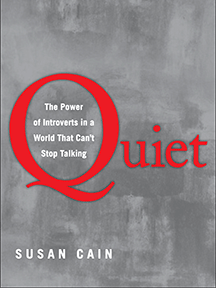By Corey Wronski-Mayersak
Quiet is a tribute to introversion and a call to reconsider how we value traits associated with it: introspection, sensitivity, seriousness, and in short, the inclination to be “a thinker.” In a world of increasing emphasis on networking, collaborative work in business and education, and social media, Susan Cain’s book is a timely and useful reminder that different styles of working, communicating, and thinking are not only beneficial, but perhaps essential to a successful society. Challenging what she sees as the dominant culture of extroversion in the twenty-first century United States, Cain ultimately argues for balance within ourselves and our communities.
According to Cain, one-third to one-half of people are introverts as a result of biological and/or environmental factors in their makeup, and she explores how this temperament comes with numerous benefits: capacity for concentration, thorough assessment of risk, willingness to delay gratification, less susceptibility to rewards, and a contemplative problem-solving process.
However, Cain argues that such individuals live under what she calls “the Extrovert Ideal – the omnipresent belief that the ideal self is gregarious, alpha, and comfortable in the spotlight.” The “ideal” is also a risk-taker, and someone who thrives on socialization and a lot of stimulation. In this atmosphere, introverts are pressured to live as “pseudo-extroverts,” often at the expense of not fully tapping their own unique talents. Cain cites, for example, the trend of open office plans designed for maximum social interaction and cross-pollination of ideas, which sacrifices introverts’ optimal working state. Invoking Virginia Woolf, Cain notes that in the majority of modern offices, “no one has a room of his or her own.”
Cain opens the book with a brief assessment of the introversion-extroversion spectrum, outlines common characteristics associated with each side, and acknowledges that most people are not entirely one or the other (she recognizes “ambiverts” as well).
The first section of the book then traces a history of the rise of extroversion in the United States, identifying the turn of the twentieth century as a key shift. Next, Cain turns to the physiology of introversion and extroversion. She amasses a review of relevant scientific literature, walking layman readers through studies of reactivity, the nature versus nurture debate, and current techniques of brain mapping through fMRI. Cain is not a neuroscientist herself, and undoubtedly this is not a complete picture of the science, but her perspective as a lawyer and consultant may account for her keen ability to condense and translate scientific information for a general audience. The third section of the book examines cross-cultural comparisons, contrasting the temperaments that are idealized in the East and West. The final chapters turn to practical suggestions for bridging the introversion-extroversion gap in business, education, family life, and other personal relationships.
At times Cain’s claims about introverts can feel a bit sweeping even despite her disclaimers that not all traits described will apply to all self-identified introverts. For instance, she admits that fear of public speaking does not apply to all introverts, and yet it is her central example of an introvert dilemma throughout much of the book. Another issue that goes largely unaddressed in Quiet is socioeconomic class difference as it impacts life experiences and opportunities. Much of the book and its advice seem to focus on people growing up in American middle and upper class environments, having access to higher education choices, and then working in professional fields. Consideration of a broader scope of experiences could serve Cain’s book well.
Nonetheless, one of the book’s greatest strengths is still its usefulness to a wide audience. Employers and managers will find thought-provoking discussion of how to optimize workplace productivity and creativity, as well as avoid some pitfalls of what Cain calls the “New Groupthink.” Parents of introverted children will gain more understanding of the world through the eyes of an introvert, along with advice on how to nurture these children’s strengths and aid them where they may struggle. Teachers of all levels will be interested in Cain’s assessment of the pros and cons of pedagogies stressing collaborative work, and her arguments for balancing and respecting the needs of students with diverse temperaments. The book will also be of interest to scholars of social identity and social performance across all disciplines, particularly because of Cain’s review of historical patterns and analysis of what the self-help industry reveals about cultural ideals.
Cain writes with humorous personal touches from her experiences as an introvert living in an extrovert’s world, making the book an intriguing narrative in addition to a well-researched statement. Some of the most compelling and entertaining portions are vivid narratives in which Cain takes us behind the scenes of her research, telling stories of her visits to research labs and immersion in extrovert-friendly atmospheres such as the executive training ground of Harvard Business School and an exuberant, high-fiving crowd at a Tony Robbins seminar.
Finally, some points about what the book is not deserve emphasis. The book is not just a cheer for introverts or a catalog of the great contributions of famous quiet and thoughtful types, although Cain does provide a long and illuminating list of them (Rosa Parks, Gandhi, and Apple co-founder Stephen Wozniack are among those Cain gives in-depth attention). It is also not an argument for the elimination of teamwork and collaboration. It is a much more nuanced study of how people live and interact together, how styles of being vary, and how we can work together most happily and most effectively.
Corey Wronski-Mayersak (ΦBK, Goucher College, 2002) is an Assistant Professor of English at McDaniel College and a resident member of the Delta of Maryland Chapter of Phi Beta Kappa.




